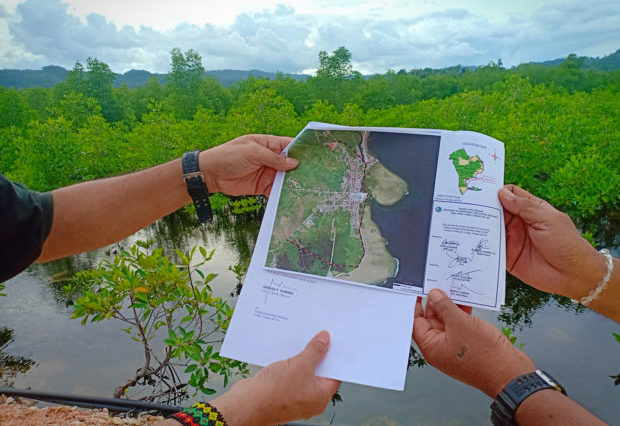
Lianga Councilor Samuel Dollano (left) and local environmentalist Macario Angela hold a map showing how the coastal road project will traverse 30 hectares of mangrove forest. (Photo by CHRIS V. PANGANIBAN / Inquirer Mindanao)
LIANGA, Surigao del Sur — Hundreds of residents of this sleepy seaside town have been opposing the construction of a 2.79-kilometer bypass and diversion coastal road, which they fear will destroy at least 30 hectares of mangrove forest.
The residents, mostly Catholic parishioners, sent a petition on Dec. 20, 2018, to the Department of the Environment and Natural Resources (DENR), but so far Environment Secretary Roy Cimatu has not acted on it.
“Why pursue a coastal highway project that would entail a huge amount of money and would destroy our rehabilitated mangrove ecosystem that would serve as a precious tourism showcase of Lianga?” the petitioners asked.
Earthworks
The Department of Public Works and Highways (DPWH) had awarded to CM Tan Construction, a company based in Butuan City, the P173-million coastal road project.
The company had started dumping limestone gravel on the starting line of the road project in December 2018 after funding for the project was included in the 2018 General Appropriations Act.
The Environmental Compliance Certificate issued to the road project provided that there should be no cutting of mangrove trees, “unless extremely necessary and only upon the approval of proper authorities.”
But a check at the project site showed that the dumped limestone had already buried mature mangrove trees near the research center of Surigao del Sur State University.
The ponds where fingerlings of different types of fish are raised for scientific research by fisheries students of the Lianga campus of the Surigao del Sur State University. (Photo by CHRIS V. PANGANIBAN / Inquirer Mindanao)
Students worry
Rofel Sarabia, a fourth year fisheries student, said they were surprised when dump trucks and other earth moving equipment came and started filling limestone in the area in between the school fishponds and the still unoccupied two-story research center.
“There would be a big impact in case a storm surge hit this town. The mangroves serve as surge natural barrier to a surge,” he said.
He said students did not really like that a diversion road would cut across their research area.
Sarabia and four other scholars of the Bureau of Fisheries and Aquatic Resources (BFAR) were doing research work when Inquirer accompanied by Lianga Councilor Samuel Dollano visited them in January.
Lianga Councilor Samuel Dollano points at the extent of damage the road project has inflicted on the mangrove forest. (Photo by CHRIS V. PANGANIBAN / Inquirer Mindanao)
BFAR’s P1.153-million mangrove rehabilitation project within the school’s research under the Philippine Aquasilviculture Program has been affected by the earthworks.
According to BFAR, aquasilviculture is a management strategy that combines and harmonizes fish production and mangrove development. The strategy brings livelihood opportunity to augment fishers income while reforesting the mangrove at the same time.
“They attack the core of the Coastal Resource Management Program in Lianga Bay and at the same time they attack the very core of life support system which is mangrove,” Dollano said.
Community Environment and Natural Resources Officer Cliff Abrahan said the contractor was obliged to do earth balling on the affected mangrove trees and transfer them to vacant areas of the mangrove forest as stipulated in the Special Land Use Permit.
He said that, based on the agreement between the DENR and the DPWH, the contractor would be required to plant at least 100 propagules for every mangrove that would die during the earthwork activities.
The P1.153-million aquasilviculture project supposed to benefit fisherfolk will be ruined once road contractor fills up the mangrove forest with limestone. (Photo by CHRIS V. PANGANIBAN / Inquirer Mindanao)
Snowballing protest
The project, an initiative of Surigao del Sur 1st District Rep. Prospero Pichay, had been opposed by local officials who passed several resolutions last year.
Local officials supported the clamor of residents, who initiated a signed manifesto in the first week of December 2018, opposing the implementation of the road project.
The manifesto circulated among residents in three affected neighboring coastal villages.
According to the manifesto, the road project runs counter to the mangrove protection and sanctuary program of the DENR, as it will destroy the breeding place and habitat of seagrass and different kinds of shellfish.
It will also destroy the P58 million bay walk project of the Department of Tourism.
Some houses along its road right of way will also be affected.
Limestones have been dumped over mature mangroves at the Fisheries Institute research area of the Lianga campus of Surigao del Sur State University. (Photo by CHRIS V. PANGANIBAN / Inquirer Mindanao)
The Municipal Agriculture and Fishery Council (MAFC) also aired a strong objection to the project. It passed a resolution as early as Feb. 22, 2018, citing the negative effects of the project to the marine ecology and to the fisherfolk in the area.
The project contradicts the original diversion road plan approved by the Municipal Development Council in the upper portion of the town.
“I just wonder why this coastal road project as insisted by Congressman Pichay suddenly came up like a mushroom,” said Enrique Layno IV, president of the Parish Pastoral Council. /atm